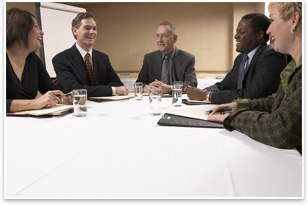
Take Your Firm to the Next Level by Rena M. Klein, FAIA How do you . . . “grow” your firm? Summary: Joe is the principal of a small firm that has grown from 4 to 12 staff members in the last two years. Despite the turmoil created by rapid growth, Joe dreams of heading a firm twice this size. He imagines taking on larger projects and creating a firm that has value beyond his personal reputation. He’s seen other firms move up to the next level, but he wonders how. Before the how question can be answered, the what question must be posed. What does the next level mean? To increase in value, firms must continue to grow, but growth could come through expanded services, increased productivity, or cultivating expertise—not only through increase in firm size.
Once this vision is understood, there must be commitment. Getting to the next level takes discipline and actions such as strategic planning, commitment to continuing education, and sometimes significant systemic change. Because architecture firms are project-based, project delivery often is the first system that needs examination. In many small architecture firms, partners are the primary project managers. Partners do all the client contact and project tracking, all information flows through them, and they are the main decision makers. Not surprisingly, partners in these firms frequently work 60-hour weeks and complain about not having time to design. Although they may want to grow the firm, these firm leaders can’t imagine how to manage more projects, employees, or even find the time to plan.
In a pyramid model, growth is only possible by adding more pyramids (partners), but growth through adding pyramids is limited. While the firm may get bigger, it is unlikely it will be more profitable, more productive, or more innovative. At worst, there may be a tendency toward competition for resources as each partner’s pyramid becomes more separate from the others. The matrix solution
By letting go of project management, firm leaders are able to focus on work that enables a firm to grow, instead of dashing from deadline to deadline. Even in a firm of two people, one owner and one professional employee, a matrix model can be applied, freeing a sole proprietor to focus on design and market development. Transforming mental models Changing mental models of how things work is probably the most difficult aspect of this process. It has been said: “Our habits are our destiny.” In small firms, the habits of the principals substantially influence every aspect of firm operations. These habits, good and bad, often become entrenched organizational patterns, copied and deepened by the staff.
It’s not hard for most designers to envision a preferred future, but actually taking the steps to get there may be another story. It is a process that takes discipline, personal commitment, alignment of purpose, and a willingness to be challenged. It must start at the top. To get to the next level, firm leaders may need to reinvent themselves along with their firms. |
||
Copyright 2007 The American Institute of Architects. All rights reserved. Home Page |
||
news headlines
practice
business
design
Recent related
› Creating an Open Climate for Communication
Rena M. Klein, FAIA, principal of RM Klein Consulting, provides assessment, strategy, and management coaching to leaders of design firms.
Klein will serve as a presenter for the Full Spectrum Practice conference, sponsored by the AIA Custom Residential Architects Network (CRAN), in Chicago on October 19-20. She will speak about the “Best Laid Plans: Business Planning for Custom Residential Architects.” For more information or to register for the conference, visit the CRAN Web site.

 Be what you want to become
Be what you want to become The pyramid problem
The pyramid problem When a talented staff member assumes a project manager role, he or she is given responsibility and challenge, inevitably resulting in increased commitment and enthusiasm. The partner in charge of a project can then support the project manager with mentoring and quality review. Some partners will also serve on the project team as the lead designer or technical expert.
When a talented staff member assumes a project manager role, he or she is given responsibility and challenge, inevitably resulting in increased commitment and enthusiasm. The partner in charge of a project can then support the project manager with mentoring and quality review. Some partners will also serve on the project team as the lead designer or technical expert. Facing the weaknesses of an organization (and its leaders) and working toward improvement has huge potential for positioning a firm for growth and change. For a small firm to develop, firm leaders must grow to trust and support the intelligent people they have hired.
Facing the weaknesses of an organization (and its leaders) and working toward improvement has huge potential for positioning a firm for growth and change. For a small firm to develop, firm leaders must grow to trust and support the intelligent people they have hired.